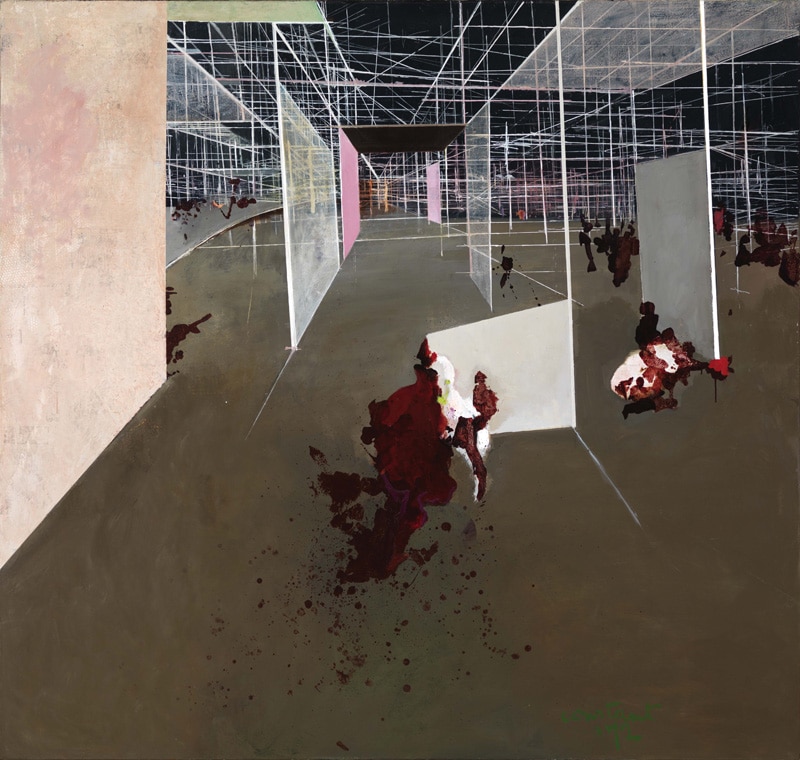Twee grote tentoonstellingen eren het werk van Constant Nieuwenhuys. Gemeentemuseum Den Haag toont zijn architectuur-utopie New Babylon, het Cobramuseum in Amstelveen schetst Constants ontwikkeling van Cobra daarnaartoe. We bezichtigen de Haagse tentoonstelling en gaan op zoek naar de erfenis van Constants legendarische project. Met onder andere enkele 3d-foto’s.
‘Geef mij toch maar Nieuw Babylon,’ schalt een popsong uit de speakers. Setting: een menselijke kolonie op Venus in een toekomstroman van Tonke Dragt. De aarde is in die toekomst volgebouwd tot een reusachtige stad, Nieuw Babylon. Dragt ontleende de naam aan het beroemde werk van Constant Nieuwenhuys, zo benoemt ze expliciet[hints] In Torenhoog en Mijlen Breed schrijft zij als verklarende voetnoot: ‘Nieuw Babylon: stedengemeenschap in Westeuropa; de naam komt reeds voor in de geschriften en op de kunstwerken van Constant, midden twintigste eeuw.'[/hints].
Helemaal gaat de vergelijking niet op: waar Dragts megastad een gevaarlijke plaats is, zonder natuur en met big brother-achtige controle, ontwierp Constant juist een vrije, utopische wereld. Een wereld voor spelende mensen, die in het machinetijdperk niet of nauwelijks meer zouden hoeven werken en tijd hadden voor menselijke uitwisseling. Een stad zo prachtig als het legendarische Babylon met zijn hangende tuinen, maar dan zonder de Babylonische spraakverwarring waaraan de stad ten onder ging.
Er zijn meer navolgers die Constants titel ‘lenen’ zonder het al te nauw te nemen met diens ideeën. Wat te denken van woon/winkelcomplex New Babylon naast station Den Haag Centraal? Een gigantische toren, die niet bepaald doet denken aan de organisch over de wereld woekerende stad die Nieuwenhuys voor ogen had. Dat woekeren is in het Gemeentemuseum prachtig te zien op bestaande landkaarten die Constant voltekende met plannen voor New Babylon.

Maar de invloed van Constant is veel groter geweest dan een toren en een boek. En dat blijkt niet alleen uit het feit dat het Gemeentemuseum vaker bruikleenaanvragen krijgt voor New Babylon dan voor Mondriaan, Picasso, Monet of Van Gogh – de succesvolle bruikleenaanvraag door het Museo Reina Sofía in Madrid stond overigens deels aan de wieg van deze tentoonstelling.
Constants invloed zit hem vooral in hoe vertrouwd veel werken aandoen. Of het nu schetsen, geschilderde impressies of maquettes zijn, over de hele linie dient het gevoel zich aan: ja, dit is hoe we tegenwoordig bouwen, zo ziet een moderne stad eruit. De publieke gebouwen dan, want voor de meeste nieuwe woonwijken geldt nog steeds de Vinex-formule.
Alhoewel.
Adri Duivesteijn, jaren wethouder ruimtelijke ordening in Den Haag en Almere, opende de tentoonstelling in Den Haag met een persoonlijk relaas. Zijn warme pleidooi voor menselijke in plaats van functionele steden is, betoogde hij, vooral ingegeven door Constant Nieuwenhuys. In beide steden waar hij bestuurder was heeft hij geprobeerd Constants gedachtegoed in te zetten bij het scheppen van nieuwe leefruimte voor mensen.
New Babylon. Aan ons de vrijheid biedt een brede kijk. Het Gemeentemuseum maakte in 1974 de afsluitende tentoonstelling van het project en bezit sindsdien veel werken. Losjes chronologisch gerangschikt komt een enorme hoeveelheid studies, bouwwerken en schilderijen voorbij. Van enkele werken zijn de originele sokkels uit 1974 gereconstrueerd en vier maquettes staan schitterend uitgelicht in verduisterde kabinetten. Zo had Constant het bedoeld.

Maar ook de spelende mens kan terecht: er zijn reconstructies van het Deurenlabyrint van de expo in 1974 en de Ludieke Trap, in 1968 gebouwd voor het Amsterdams Historisch Museum. Ze geven de bezoeker de sensatie van de flexibele stad, waarin functie en indeling van de ruimte steeds kunnen veranderen. Ook in het Cobramuseum zijn reconstructies te vinden: van Een ruimte in kleur, ontwikkeld samen met Aldo van Eyck en Lucebert, en van Kleurenharmonie in uw woning, een samenwerking met Gerrit Rietveld.
Alles geeft blijk van een gedegen aanpak en uitgebreid onderzoek. Zo verschijnen er maar liefst drie boeken: een catalogus van elk museum en een nieuw kinderkunstboek, Spelen in Nieuw Babylon.
Het is raar te bedenken dat Constant zijn project in de jaren zeventig afsloot omdat de geesten er nog niet rijp voor zouden zijn. De invloed van zijn werk op ons huidige leven lijkt namelijk nauwelijks te onderschatten. Ongeacht of hij onze tijd goed heeft voorspeld of dat de architectuur hem massaal is nagevolgd – wij leven allemaal in New Babylon.
- Constant – New Babylon. Aan ons de vrijheid, Gemeentemuseum Den Haag
- Constant. Ruimte + Kleur. Van Cobra naar New Babylon, Cobramuseum Amstelveen
- Beide tentoonstellingen lopen tot en met 25 september 2016.
3d-foto’s:
Bekijk deze 3d-foto’s met een rood-blauwe bril
